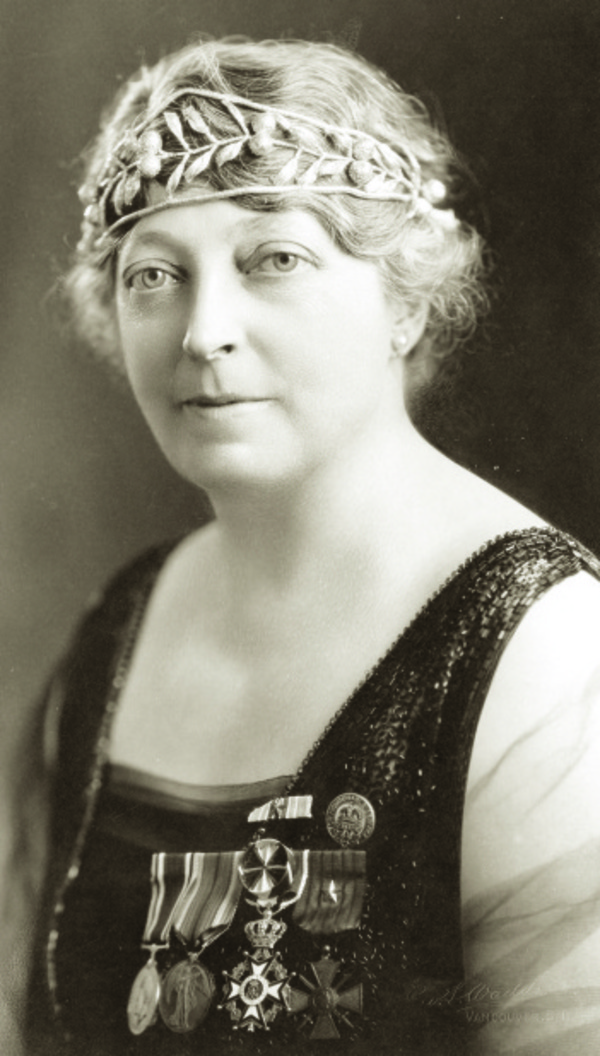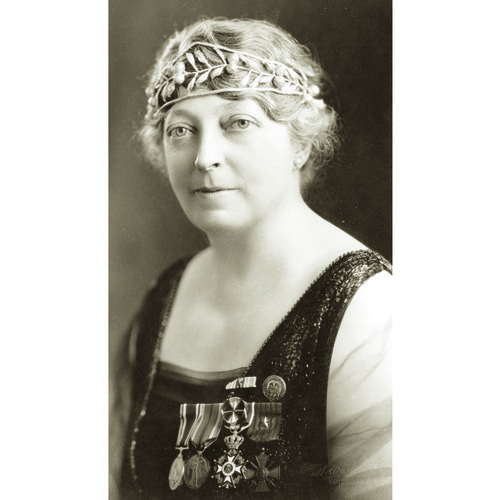
Source: Courtesy of Wikimedia Commons
Henderson, Julia WiLlmotHe (Henshaw) (named at birth Julia Willmotte, her middle name is often spelled Wilmotte, and in later life she wrote it as Willmothe; also known as Julian Durham and G’wan), journalist, novelist, mountaineer, botanist, photographer, and lecturer; b. 8 Aug. 1868 in Durham, England, seventh daughter of William Henderson and Lucy Durham; m. 15 June 1887 Charles Grant Henshaw (d. 1927) in Montreal, and they had one daughter; d. 19 Nov. 1937 in Vancouver.
Although Julia Henderson would live most of her adult life in western Canada, she grew up in Durham, England, probably in comfortable circumstances. By 1871 her father, a prosperous carpet manufacturer, employed over 500 workers in the business he owned with his brother. Julia’s parents had eight children and almost as many servants; she was educated by governesses and tutors, and sometime during her youth she studied in France and Germany. Like many other 19th-century women intrigued by science, she was influenced by her father. A keen outdoorsman, he would be the author of a popular book on angling, and he spent much time with Julia, his youngest daughter, who developed an early interest in nature and open-air adventure, including mountain climbing. She also began to write at a young age, and is said to have contributed to the Girl’s Own Paper (London).
By 1881, for unknown reasons, Julia was no longer at home with her parents. Aged 12, she lived in Durham with her sister Lucy and her brother-in-law, John George Norton, a clergyman. She likely moved with them to Montreal when Norton accepted the position of rector at Christ Church Cathedral in 1884.
In 1887 Julia married investment broker Charles Grant Henshaw. According to the Canadian Magazine she continued to write, and published articles in the Montreal Daily Star, although none has come to light. Three years later the couple and their daughter, Doris, took the train to British Columbia and settled in Vancouver. The west opened up new vistas for Julia. She found new subjects and markets for her articles while her husband worked as a commission merchant and served as a jp. The Henshaws shared a sense of adventure and in British Columbia Julia was able to indulge her interests in botany, photography, and the exploration of uncharted territory, first in the Rocky Mountains and later by mapping part of the interior of Vancouver Island. Highly energetic, she sought to recreate the social and cultural milieu she had known in England; a society hostess, she was among the founders of the Vancouver Woman’s Musical Club, the Georgian Club (honorary treasurer, 1911–12), and the Alpine Club of Canada (honorary secretary, 1910–12, 1914–20). She was active in the Vancouver branch of the Women’s Canadian Club, in which she served as vice-president about 1911; the Imperial Order Daughters of the Empire [see Margaret Smith Polson*], of which she was national vice-president in 1916; and the Canadian Society of Authors, of which she was vice-president of the provincial section in 1924.
In 1894 Henshaw began to write for the Province (Victoria). After the paper became a daily in March 1898 and was moved to Vancouver she was its book-review editor and theatre critic under the pen name Julian Durham, which she used for what she considered her serious work. From 1900 to 1910 she edited the Sunday page of the Vancouver Daily News-Advertiser, and as G’wan, the pseudonym she reserved for “women’s work,” she was the paper’s social editor. After the establishment of the Vancouver Sun in 1912, she edited its book page and wrote the “Note book” column; she contributed until her death.
As Julian Durham, Henshaw published two articles in the Canadian Magazine: “Vancouver, a twelve year old city” in 1898, and “The queen city of British Columbia” the following year. Her first novel, Hypnotized? or, The experiment of Sir Hugh Galbraith: a romance, written under the same pen name, also appeared in Toronto in 1898. She was British Columbia’s first female novelist. After 1900, perhaps because of the success of her novel, she began to issue her works under her married name. Why not, sweetheart? (Toronto, 1901), a novel set in the southern part of the province, appeared when she was 32 years old. The book, which the Literary history of Canada describes as an “extravagant melodrama,” includes her observations on the climate, geography, flora, and fauna and depicts her personal experience with the land and the people. It reflects the prevalent belief in the “unlimited possibilities of the great Canadian West … her inexhaustible wealth, and the dauntless energy of her settlers that strikes the keynote of their success.”
Henshaw’s ventures into the Rocky Mountains and her interest in photography and botany resulted in the publication of several guides on plants. Like the publications of Catharine Parr Traill [Strickland*], an earlier British immigrant, her books were based on her field experience. Henshaw’s Mountain wild flowers of Canada: a simple guide to the names and descriptions of the flowers that bloom above the clouds (Toronto, 1906) elicited some resentment from her colleague Mary Townsend Schäffer [Sharpless]. Henshaw had learned the photographic techniques of Mary and her husband, Charles, both Rocky Mountain explorers and naturalists, and benefited from their studies. By publishing before them, she pre-empted the attention their work might have received. Her book, brought out in the United States as Mountain wild flowers of America … (Boston, 1906), and her subsequent volume, Wild flowers of the North American mountains (New York, 1915), were the first North American guides to alpine plants. They were innovative in the use of photographs rather than lithographs, and the contents were arranged according to colour of the blossoms rather than in taxonomic order (used for many plant guides), or, like Traill’s Canadian wildflowers (Montreal, 1868), according to the seasons. In addition, Henshaw published several articles on mountain vegetation in the Canadian Alpine Journal (Calgary), starting with its first issue in 1907. Throughout the early 1900s she wrote on alpine flowers, gardens, travel in western Canada, mountaineering, and other outdoor recreations for the Canadian Magazine and many other Canadian, American, and British periodicals; her articles were often accompanied by photographs, some of which were probably her own.
During the First World War, while her husband worked as a recruiting officer in Vancouver, Henshaw, an honorary captain in the British Red Cross Society, visited the front to ascertain the non-medical needs of Canadian patients and medical personnel and then gave lectures across Canada, raising funds to provide comforts for the wounded. Later she drove an ambulance in France and acted as a director of the Red Cross there. For her services she was awarded the Croix de Guerre by the French government. After the war she returned home to resume her exploring, writing, and lecturing. She had been elected a fellow of the Royal Geographical Society in 1913, and in 1920, as a delegate of the Alpine Club of Canada, she attended the international Alpine Congress in Monaco, where she delivered several slide-illustrated presentations on the Rockies. These were well received and she was made an officer in the country’s Order of St Charles. A popular speaker, she gave a talk about the Columbia River to the Victoria League in London in 1924; the following year she addressed the Royal Society of Arts and the Royal Scottish Geographic Society on Canada’s national parks. She was at that time a director of the Canadian National Parks Association. Henshaw Creek on Vancouver Island was named for her. These and other honours were testimony to her accomplishments.
Julia Henshaw was writing up to the time of her death in 1937; an uncashed cheque from the Sun Publishing Company was among her effects. Her estate, valued at just over $6,047, was inherited by her daughter. Energetic and determined, she left another legacy in the number and variety of her books and articles.
BANQ-CAM, CE601-S63, 15 June 1887. BCA, GR-1415, file 23316; GR-2951, no.1937-09-536536. City of Vancouver Arch., Add. mss 54 (J. S. Matthews coll.), topical files, Henshaw, Charles [and] Julia. Durham County Council, Register Office (Bishop Auckland, Eng.), Reg. of births, Saint Nicholas, 8 Aug. 1868. National Arch. (G.B.), RG 10, piece 4966, f.12, pp.17–18; RG 11, piece 4961, f.19, p.31. Windermere Valley Museum and Arch. (Invermere, B.C.), A314, A315 (Julia Henshaw photographs). New York Times, 21 Nov. 1937. Vancouver Daily Province, 19 Nov. 1937. M. G. Ainley, “Last in the field? Canadian women natural scientists, 1815–1965,” in Despite the odds: essays on Canadian women and science, ed. M. G. Ainley (Montreal, 1990), 25–62. B. M., “Canadian celebrities: no.XXX, Julia W. Henshaw,” Canadian Magazine, 18 (November 1901–April 1902): 220–21. J. S. Beck, No ordinary woman: the story of Mary Schäffer Warren (Calgary, 2001). Canadian annual rev., 1919, 1927. Canadian men and women of the time (Morgan; 1912). Canadian who’s who, 1936/37. Joseph and Nesta Dunn Ewan, Biographical dictionary of Rocky Mountain naturalists: a guide to the writings and collections of botanists, zoologists, geologists, artists, and photographers, 1682–1932 (Utrecht, Netherlands, 1981). “In memoriam: Julia W. Henshaw, F.R.G.S., 1869–1937,” Canadian Alpine Journal ([Banff, Alta]), 25 (1937): 128–31. Marjory Lang and Linda Hale, “Women of The World and other dailies: the lives and times of Vancouver newspaperwomen in the first quarter of the twentieth century,” BC Studies (Vancouver), no.85 (spring 1990): 3–23. Literary History of Canada: Canadian literature in English, ed. C. F. Flinck et al. (2nd ed., 4v., Toronto, 1976–90), 1: 314. Rosemary Neering, Wild west women: travellers, adventurers and rebels (Vancouver, 2000). E. O. S. Scholefield and F. W. Howay, British Columbia from the earliest times to the present (4v., Vancouver, 1914). Cyndi Smith, Off the beaten track: women adventurers and mountaineers in western Canada (Jasper, Alta, 1989). Who’s who in Canada, 1923/24. Who’s who in western Canada … (Vancouver), 1911. Who was who among North American authors, 1921–1939 (2v., Detroit, 1976).
Cite This Article
Marianne Gosztonyi Ainley, “HENDERSON, JULIA WILLMOTHE (Henshaw) (Julian Durham, G’wan),” in Dictionary of Canadian Biography, vol. 16, University of Toronto/Université Laval, 2003–, accessed April 29, 2025, https://www.biographi.ca/en/bio/henderson_julia_willmothe_16E.html.
The citation above shows the format for footnotes and endnotes according to the Chicago manual of style (16th edition). Information to be used in other citation formats:
| Permalink: | https://www.biographi.ca/en/bio/henderson_julia_willmothe_16E.html |
| Author of Article: | Marianne Gosztonyi Ainley |
| Title of Article: | HENDERSON, JULIA WILLMOTHE (Henshaw) (Julian Durham, G’wan) |
| Publication Name: | Dictionary of Canadian Biography, vol. 16 |
| Publisher: | University of Toronto/Université Laval |
| Year of revision: | 2018 |
| Access Date: | April 29, 2025 |



